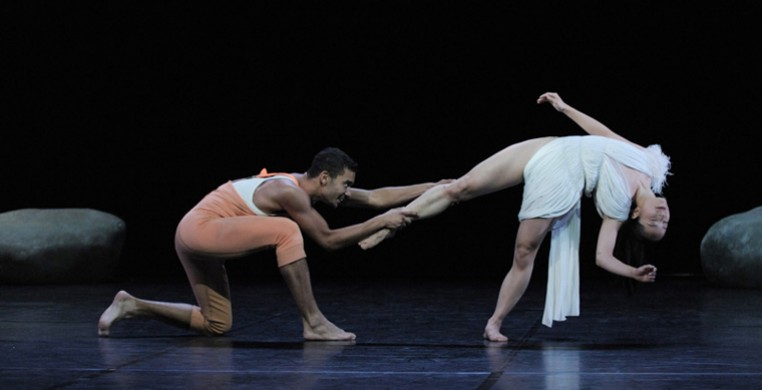Fairy tales are much more than stories for children, says Angelin Preljocaj, Artistic Director of Ballet Preljocaj, in a brief phone conversation with SeeChicagoDance. Preljocaj brings his Blanche Neige (Snow White) to the Harris Theater for Music and Dance May 2-4. The work is a modern take on the traditional grand story ballet after the classic Brothers Grimm tale of the beautiful girl with ebony skin and dark black hair. Residents of Aix en Provence, Ballet Preljocaj’s visit to the US has been six years in the making, and the Harris is on a short list of US venues to present the ballet. A representative from the Joyce Theater Foundation saw the premiere in France in 2008, and it’s taken this long to coordinate a tour of the massive production that’s making two additional stops at the Los Angeles Music Center and Lincoln Center in New York. When asked about bringing an older work on tour, Preljocaj sees it as a way to confront the ephemeral nature of dance. “I like the idea that ballets can live longer, like other forms of art.” Paintings and music live on past their premieres, and dance isn’t always afforded that opportunity. By revisiting a previous work, Preljocaj also noted the changes that occur from fresh casting. “The dancers give their own experience and life…it feels alive… [dance is] always changing by people who dance it,” he said.
Dubbed by some to be “the sexy ballet,” Blanche Neige carries with it a number of interesting juxtapositions. Provocative and edgy costumes designed by legendary haute-couture designer Jean Paul Gautier are layered over athletic contemporary choreography in a traditional story ballet structure set to a score of Mahler symphonies. Preljocaj prefers to think of the ballet as more sensual than sexual, and sought to create an experience that was accessible and enjoyable to children and adults alike. “Fairy tales are the collective unconscious of civilization. They are about morals…what life is full of. Many feel that fairy tales are not for children. They are violent. Children understand good and bad, and they have their own vision.”
The story of Snow White, when interpreted through a modern lens, permeates some of the most culturally relevant themes of this generation. Race, the media, and society’s view on what and who is attractive - “the fairest of them all” - are part of a social construct that has been dubbed “The Snow White Complex.” Irony: YouTube preceded a documentary of the same name, which interviewed women of different races on what it is like to live in their skin, with an ad for Jergen’s “body correcting skin cream” (“Firms, lifts, corrects”). The Snow White Complex as interpreted by Preljocaj goes beyond skin color and race. He talked about the changing relationships between mother and daughter due to the roles of science and technology in our lives. “A woman in her forties is now considered young,” he said, and there is a conflict between mothers and daughters who share similar experiences. Women of different generations are now sharing similar likes and dislikes in clothes, music, and other interests. The mother, through our societal advancements, has the ability to experience an extended youth, and live vicariously through her daughter. Jealousy and envy ensue as mother and daughter fight over beauty and youth, as when the Queen tries to off Snow White on several occasions to maintain her status as the most beautiful woman in the land.
Preljocaj sought to explore these modern day connections to the tale in his ballet, in a format that reached its height at the crux of the Romantic and Classical eras of dance. German romantic literature was peaking around the same time as the story ballets, and while it might have made sense to present the contemporary ballet with an original score, Preljocaj chose Mahler deliberately as a composer who lived in both the Romantic and Modern ages. The result is a feast for the eyes, ears, and mind, and a (presumably) not-to-be-missed performance at the Harris.

